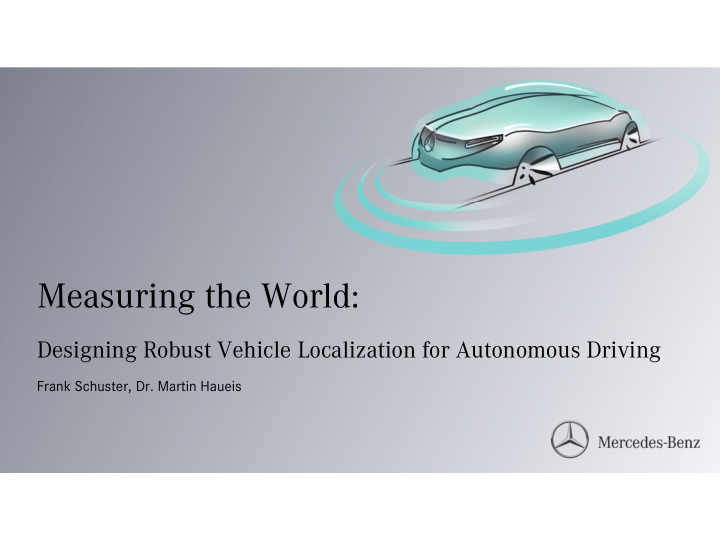



Measuring the World: Designing Robust Vehicle Localization for Autonomous Driving Frank Schuster, Dr. Martin Haueis
Agenda • Motivation: Why measure the world for autonomous driving? • Map Content: What do we need to know about the world for autonomous driving? • Mapping Algorithms: How can we measure the world? • Challenges: But can we really measure the entire world? 2 Measuring the World – F. Schuster, M. Haueis
Why measure the world for autonomous driving? • Typical sensor range (stereo camera) approx. 40 m • To drive autonomously, planning 5-10 seconds ahead • Need to know information beyond the sensor range • Highly accurate and up-to-date maps to calculate drivable area • Reliable localization algorithms to choose map segment 3 Measuring the World – F. Schuster, M. Haueis
What do we need to know about the world for autonomous driving? • Navigation Maps: Information per road • Autonomous Driving: Information per lane • planning information (speed limits, lane merges, intersections) • Localization information (sensor compatible representation of the environment) How can we do this? Courtesy HERE 4 Measuring the World – F. Schuster, M. Haueis
Map Content 2 1 3 Courtesy Mapillery Courtesy HERE Courtesy HERE 1. Road Connectivity for navigation 2. Precise road geometry for path planning 3. Semantic information for situation analysis and localization 5 Measuring the World – F. Schuster, M. Haueis
Mapping Today @ HERE • Mapping of the world with LiDAR and camera setups combined with RTK GPS • Data mining and Deep Learning algorithms extract significant objects 1. IMU (lanes, speed limits, localization 2. Camera Setup 3. Velodyne LiDAR objects, …) from raw data in post 4. GPS Antenna processing • GPS for precise geolocation of all map attributes http://360.here.com/2015/04/07/anatomy-mapping-cars-dummies/ 6 Measuring the World – F. Schuster, M. Haueis
7 RD/FA
Increasing the Robustness of the Mapping Process - Automation Courtesy FZI@KIT (C. Stiller) 8 Measuring the World – F. Schuster, M. Haueis
Increasing the Robustness of the Mapping Process – Sensor Setup Courtesy FZI@KIT (C. Stiller) Measuring the World – F. Schuster, M. Haueis
Increasing the Robustness of the Mapping Process – Data Representation Courtesy FZI@KIT (C. Stiller) 10 Measuring the World – F. Schuster, M. Haueis
Industrialization • Minimal set of specifiable landmarks • Simple representation • Robust object classes that are detectable by automotive grade sensors Formal beschreibbares Minimalset Kartenattribute Industrialisierbarkeit Page Title of presentation / Department / Date / 11
Mapping Algorithms – Grid 12 Measuring the World – F. Schuster, M. Haueis
Mapping Algorithms - Features 13 Measuring the World – F. Schuster, M. Haueis
Mapping Algorithms - Context Need a more high level representation of the world to achive both scalability, accuracy and integrity requirements. Source: An Empirical Evaluation of Deep Learning on Highway Driving, 04/2015, Standford University, Brody Huval et al. 14 Measuring the World – F. Schuster, M. Haueis
Scalability: Exploration of new Areas Initial Map • Constraints forming graph map � � � � ������� � � � � � �� • Solve GraphSLAM problem by graph optimization min �,�� � � • Result: optimized mapping trajectory ( � ) • Optimized radar landmarks ( �� ) • => Optimized landmark positions �� used for localization 15 Measuring the World – F. Schuster, M. Haueis
Measuring the World – F. Schuster, M. Haueis 16 RD/FA
Scalability: Exploration of new Areas Fully performing map • Constraints forming graph map � � � � ������� � � � � � �� • Solve GraphSLAM problem by graph optimization min �,�� � � Now: Consider � � … � ��� graph maps • ��� ��� � ��� � ∑ + ∑ � � � �� • Then we can find an overall cost function ��� ���,��� => Optimizing � ��� yields Cost of all maps Cost of interactions � and �� for all trajectories by themselves between maps 17 Measuring the World – F. Schuster, M. Haueis
Measuring the World – F. Schuster, M. Haueis 18 RD/FA
Collective Mapping – Startups show the way Startups like Mapillary • #CompleteTheMap - A challenge to map your city • Mapping large areas with deep learning from dash cam images mostly • Semantic labelling provides planning information (lane markings, traffic lighs) and localization objects 19 Measuring the World – F. Schuster, M. Haueis
Radar – Ground Facing • Ground facing radar used for mapping of the density distribution below the road surface • Highly robust towards changing weather and driving conditions (rain, snow, off-road…) • Centimeter level accuracy and The Localizing Ground-Penetrating Radar (LGPR), courtesy MIT https://www.ll.mit.edu/publications/technotes/TechNote_LGPR.pdf high availability • However radar array requires a lot of power, not applicable in production vehicles today. However automotive radars can be used. 20 Measuring the World – F. Schuster, M. Haueis
Scalability: Scene Understanding • High Level features enable map updates on a large scale • But reliable detection and classification more difficult than ever • Cityscapes Dataset (Vision) • Semantic, instance wise and dense pixel annotations • 30 Classes (dynamic and static) • 50 Cities over several months “The Cityscapes Dataset for Semantic Urban Scene Understanding”, M. Cordts et al. www.cityscapes-dataset.net 21 Measuring the World – F. Schuster, M. Haueis
Summary • Need robust localization for path planning in autonomous driving applications • Localization pinpoints location in map to interpret map data correctly • Feature Maps use sparse representations of the world, but are usually proprietary to the sensor setup and algorithms • Goal: High Level classified feature maps that can be shared among a fleet of cars from different OEMs 22 Measuring the World – F. Schuster, M. Haueis
Conclusion - So, how can we measure the world? • Using a sparse, high level description of the world • By interpreting semantic information about the world • By having every car with sensors contribute in map updates 23 Measuring the World – F. Schuster, M. Haueis

Recommend
More recommend